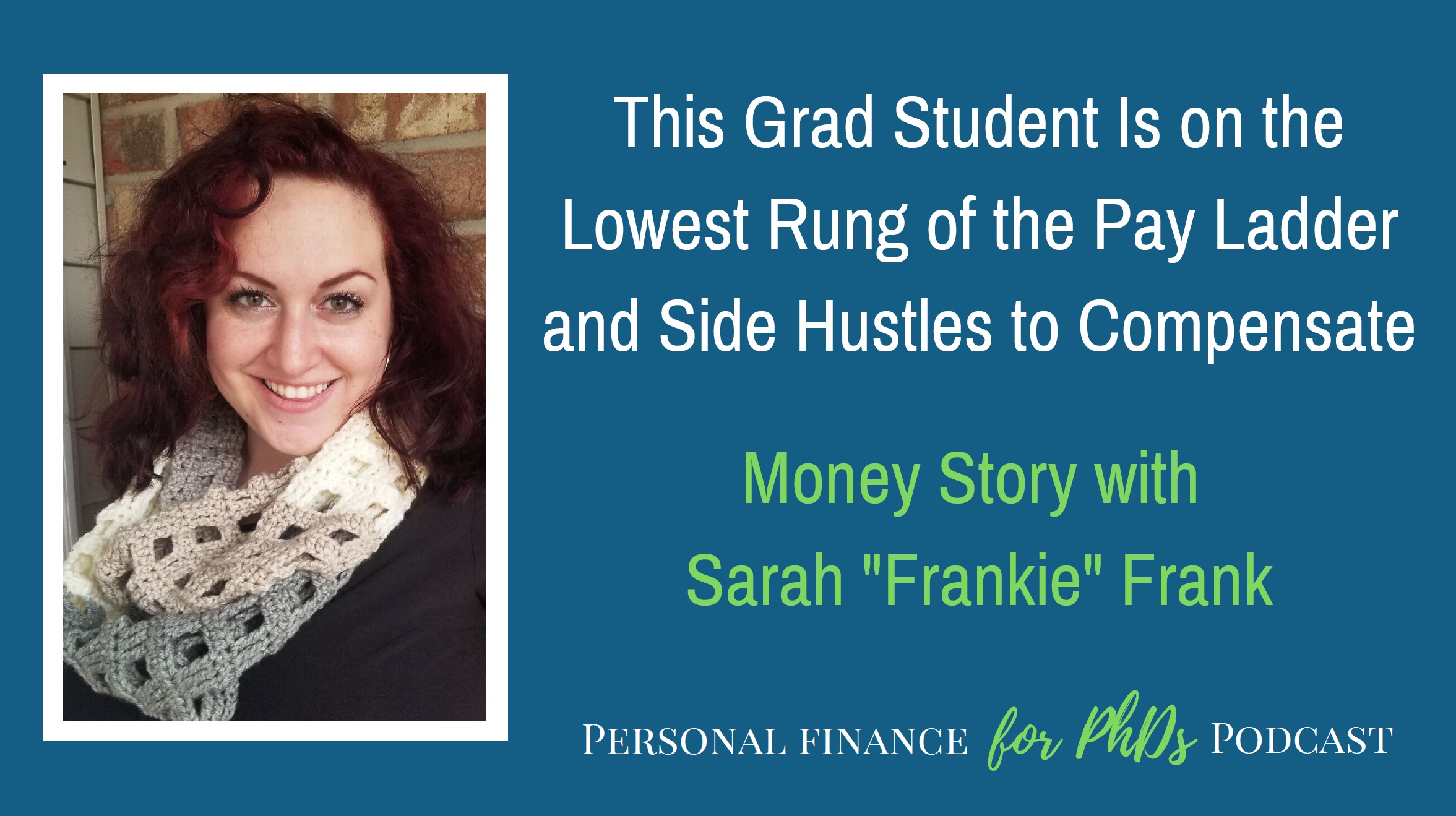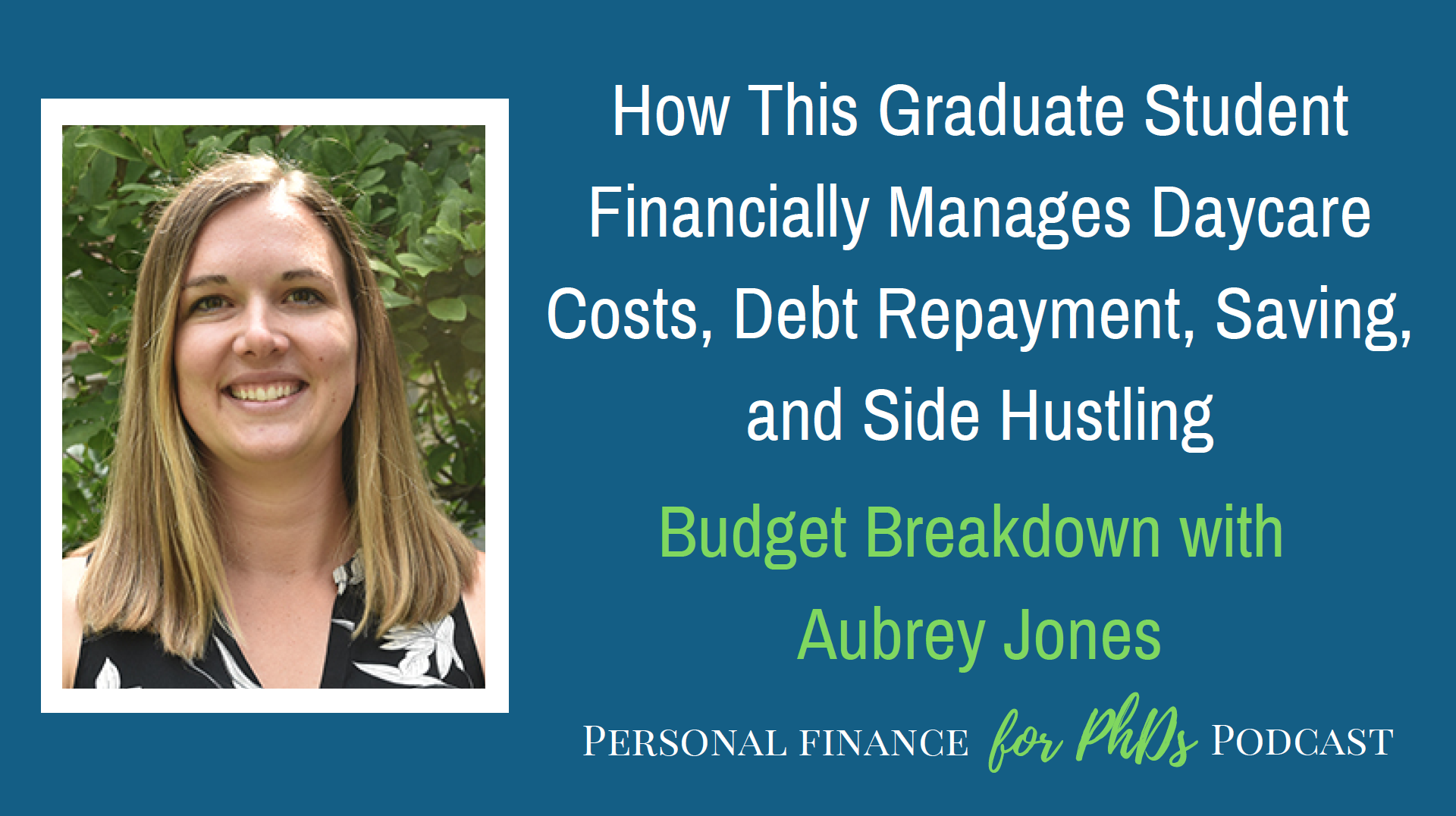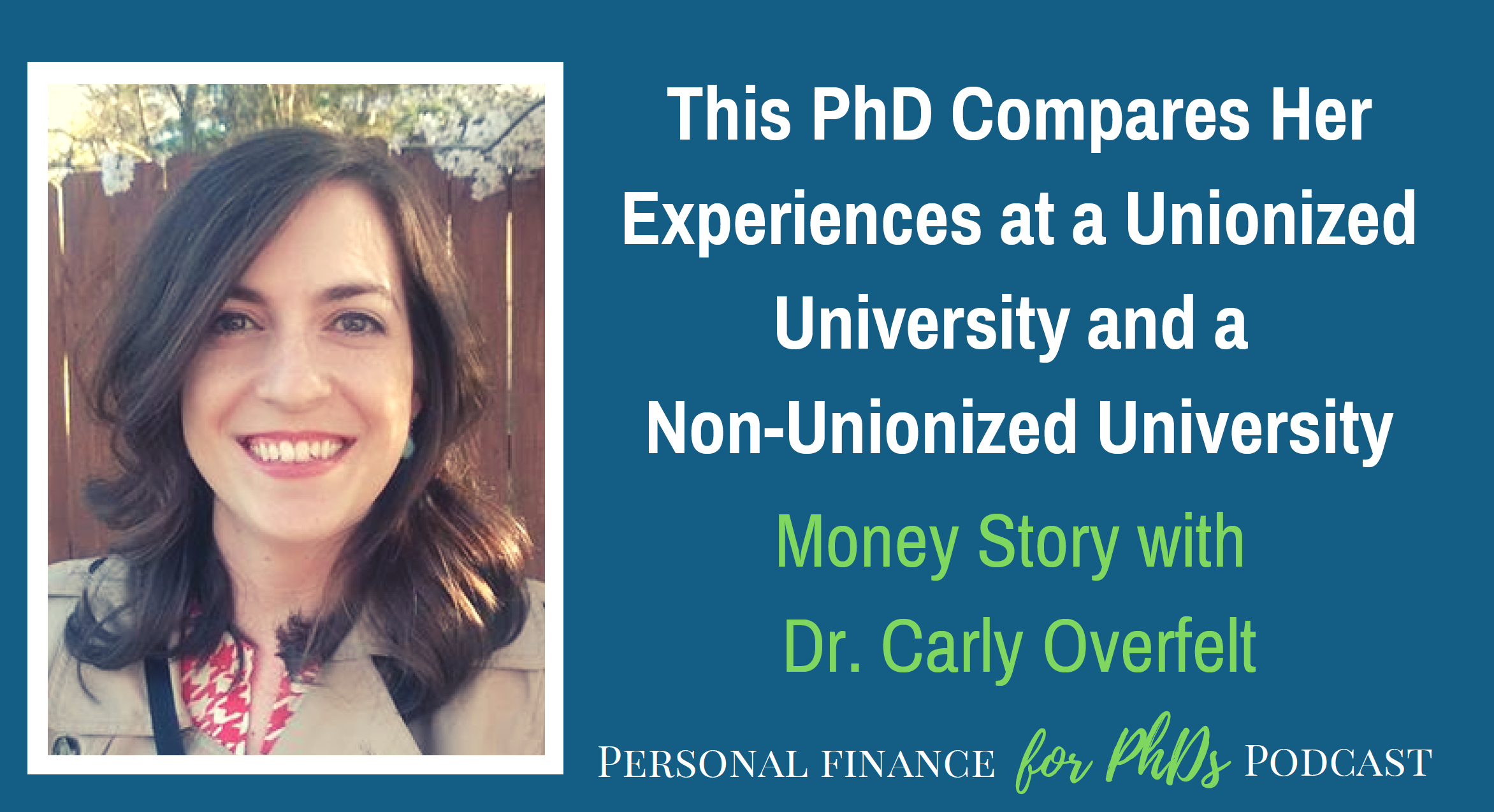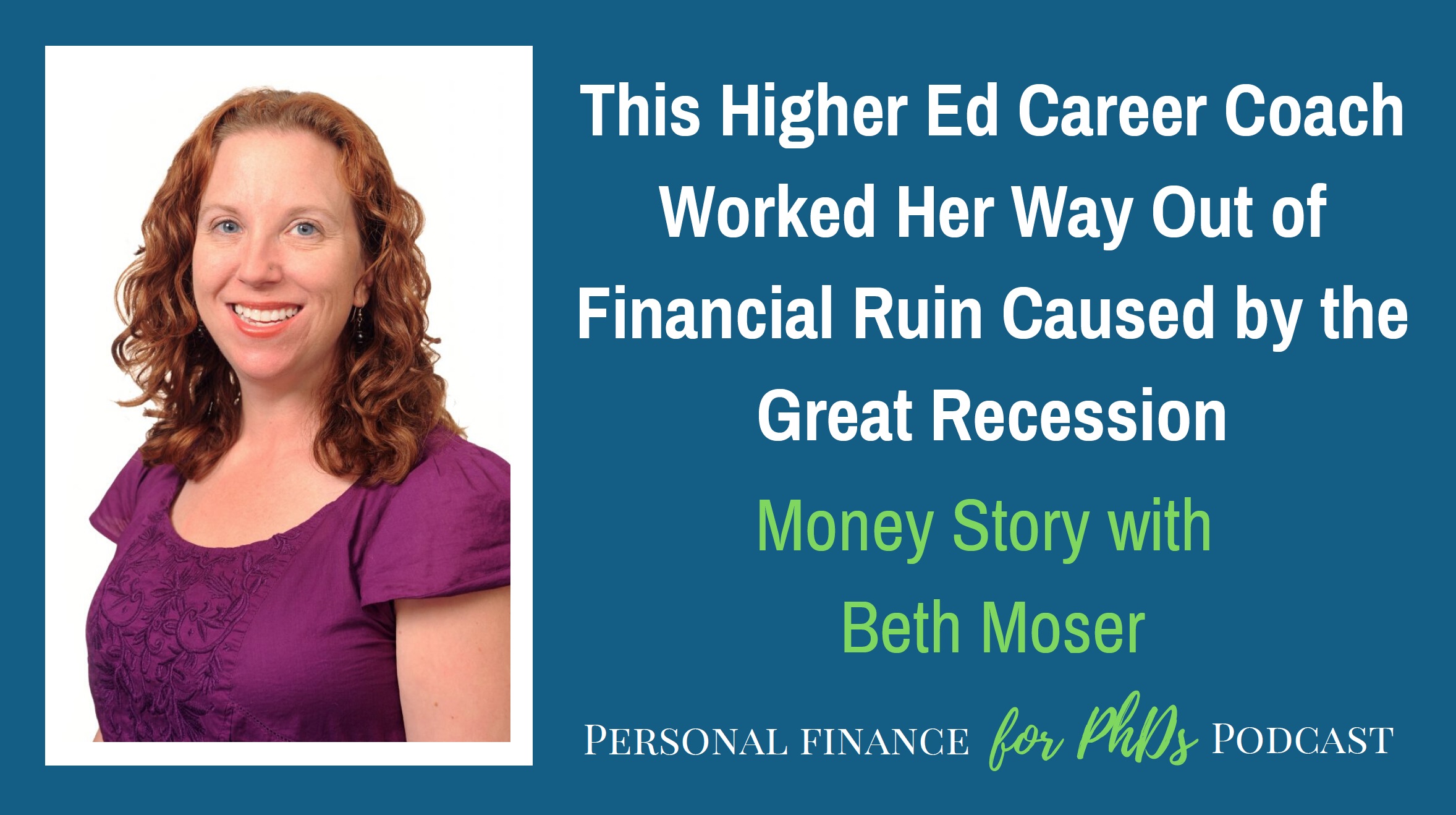In this episode, Emily interviews Sarah ‘Frankie’ Frank, a grad student in sociology at the University of Wisconsin-Madison. Frankie describes the hierarchy of grad student positions at UW; the positions she’s primarily held over her years in grad school, teaching assistantships, are on the lowest level in terms of hourly pay. To make ends meet, Frankie side hustles doing activities that she truly loves, chiefly tutoring and baking. She concludes the interview with excellent advice for a grad student who wants and needs to do it all.
Links Mentioned in the Episode
- PhD Stipends Database
- Before Admission Season Starts, Determine what Standard Offer in Your Field Is
- @frankies.cupcakes (Instagram)
- https://frankies-cupcakes.com/ (Website)
- https://www.facebook.com/frankies.cupcakes.yum/ (Facebook)
- Personal Finance for PhDs: Podcast Hub
- Personal Finance for PhDs: Subscribe to Mailing List
Teaser
00:00 Frankie: You feel so subjected to whatever the institution tells you you’re worth–what you can do, what you can’t do–and the honest truth is that you have a little bit of bartering that you can negotiate. If you are in a position that you can make that kind of offer, you should because it’s possible that they find that money somewhere.
Intro
00:22 Emily: Welcome to the Personal Finance for PhDs podcast, a higher education in personal finance. I’m your host, Dr. Emily Roberts. This is season five, episode six, and today my guest is Sarah Frank who goes by Frankie, a grad student in sociology at the University of Wisconsin-Madison. Throughout most of grad school, Frankie has been a teaching assistant, a position that receives the lowest hourly pay rate at her university. We discuss the various types of positions a grad student might have and the advantages of being paid through a fellowship or research assistantship. Frankie’s $15,000 per year stipend isn’t enough to make ends meet, so she is engaged in many side hustles, the best of which were tutoring NCAA student athletes and her cake business. You won’t want to miss the advice Frankie gives at the end of the interview to grad students who are juggling a lot of responsibilities and activities at once. Without further ado, here’s my interview with Frankie.
Will You Please Introduce Yourself Further?
01:22 Emily: I’m delighted to be joined today on the podcast by Sarah Frank who goes by Frankie. And we’re going to be talking today about TA-ing, having a teaching assistantship and how that compares to other jobs you might have on campus as a graduate student. So, Frankie, thank you so much for joining me today.
01:38 Frankie: Thank you, Emily. I really am excited to be here. I feel honored.
01:42 Emily: Oh, well that’s lovely to hear. Would you please tell us a little bit more about yourself, you know, where you go to school and so forth?
01:48 Frankie: Yeah. So, my name is Frankie. I am a PhD candidate and a lecturer now at the University of Wisconsin-Madison in the Department of Sociology and in the Department of Legal Studies. I’ve previously spent three years as a teaching assistant and lecturer. I’ve also worked for athletics. And yeah, I think I have about two years to go before I have a job somewhere, hopefully.
02:10 Emily: Sounds good. So, you’ve already mentioned you’ve had a few different positions, so let’s talk about what your current position is and what your pay is right now.
02:20 Frankie: Yeah, so current position for lecturers, right now it depends on how many students will be enrolled in the course, but at a 33% appointmentship for one course in the fall, I’ll make about $7,000. So, over the whole course of the year, that can fluctuate to about a $15,000 baseline salary. And then adding in other jobs thereafter, I don’t make more than about $22,000 a year.
Level of Pay Variation at UW-Madison
02:45 Emily: Okay. So, that gives us a good idea of the range. So at a 33% appointment, if you did that approximately for the whole year, it would be about $15 K. Plus, your side hustle and such, have other jobs on top of that, of course, to make that work, naturally. Okay. And how has that level of pay varied over your time in graduate school?
03:06 Frankie: Yeah. So, when I first came as a TA in 2016, University of Wisconsin had one of the lowest pay rates for TAs. So, in our tiers of graduate studentship, being a teaching assistant was at the very lowest, at about 15 and a half thousand dollars per year at a 50% appointmentship. And then the union here, there’s a teaching assistant union that put a lot of pressure on our administration to raise that salary. So, we have gotten substantial raises. And then just this year, lecturers also got another bit of a raise. So, it has increased a little bit as we’ve gone on. But we still pay student fees. So, we pay segregated student fees that go into like student clubs and student rec centers that are mostly undergraduate. So, we lose a little bit of our salary there to the tune of six or $700 each semester that you’re taking full load.
03:55 Emily: Yeah, that is a huge bite. Okay. So, I just want to add in like a couple of notes there for the listener. So, if you want to see what other people are being paid at Wisconsin or in other places, one of the websites I run is phdstipends.com. So, go there and check out what TAs and RAs and other types of grad students, fellows are being paid in various places and enter your own data. So, there are a couple of things you mentioned I want to follow up on. You mentioned that TA pay was the lowest among the different sort of options, the way graduate students might be paid. So, what are those other options at Wisconsin?
04:31 Frankie: So, typically the lowest tier would be teaching assistants. The next tier up would be research assistant, and the tier after that would be project assistant. And then the top tier is obviously fellowship. So, if you’re on fellowship, you make the most. After the raise, teaching assistant and research assistant are more in line with one another. So, this is the first year that they’re really in line.
04:54 Emily: Yeah. That was something curious that you said that I wasn’t really sure about, that TAs and RAs had been paid differently. Now you mentioned that the union was just a TAs union, or does it also cover RAs?
05:09 Frankie: Right, so it’s strange. It’s called the Teaching Assistant Association, so it would sound like it’s just for TA’s, but it’s actually for all graduate student workers. So, it includes RAs, PAs, and it includes people on fellowship actually as well. So, graduate student workers generally.
What is a Project Assistant?
05:23 Emily: Okay. That’s really interesting to hear. I would love to follow up more on that actually with you, but I actually have multiple episodes scheduled with other people talking specifically about unionization movements at their own university. So, I’m excited to dive into that more in other episodes. But I’ve never heard of this job title, project assistant before. Can you tell me what that is?
05:43 Frankie: So, there are research assistants and project assistants, and it depends wholly on the grant that a supervising faculty applied for or the amount of responsibility or ownership that the student is taking over the project. In the mix, there is something called a traineeship, which seems to be blended with both project assistant and research assistant. I think it’s a matter of just titles, honestly. Because I’ve heard very different projects, very different gamuts, it depends on the department, what they call a traineeship versus a research assistant or project assistant. To me it sounds like, as far as hours worked, I know that teaching assistants have the most, and then research assistants have the second most followed by project assistants and trainees, and then fellows should have the least amount of work. They’re not required to do any specific work activities.
06:34 Emily: Okay. So, you mentioned a 50% appointment for a TA position, so that’s ostensibly 20 hours per week, is that right?
06:42 Frankie: Yeah, it’s supposed to be 20 hours a week. Yeah.
06:43 Emily: Yeah. Well, we all know how that really goes. So, what is it for RAs and PAs then? Do you know?
06:49 Frankie: They’re supposed to be 20 hours a week as well.
06:52 Emily: But in reality…
06:54 Frankie: Yeah, so the common thread is people know that RAs and PAs don’t work that much. They usually do closer to like 10 or 15 hours a week, if that.
RA-ing Does Not Always = Dissertation Work
07:04 Emily: Okay. So, this is something that I and other people get a little bit confused or conflate together. So, are you talking about for an RA position, a research assistantship, is that distinct from the student’s dissertation work?
07:22 Frankie: So, this is a really good question. It can be. It may be that’s the way you are earning your income, working on a supervising professor’s work and using their data. And depending on your relationship with that professor or what you want to do for your dissertation, their data might be your dissertation. And in some cases it is, but in other cases it’s not. So, the way that those things help you out in the long run dissertation-wise varies. The variation is incredibly wide.
07:52 Emily: Yeah. Because it’s always seemed to me–so, I come from a STEM field, biomedical engineering. And so what was common in my field and others that I observed in STEM is that most of the time most people had RA positions, and their RA work was the same as their dissertation work. So, it was like, really, once your classes were done and so forth, your full-time efforts could go towards your dissertation. And, you were also being paid off of the grant to do that work. Now, that means you don’t have as much freedom in what you do because it depends on what the grant is, of course. And so it’s all worked out between you and your advisor. I do think that it was more rare in my observation to see someone have an RA position that was different from their dissertation work. But it sounds like that is maybe more common where you are. And I’m sure this is very like field-dependent, right?
08:40 Frankie: So, in sociology, because someone might be working on some specific project long-term, or like a demographic project that takes many years of data collection, people might use some part of a dataset. Or you know, they’re becoming really familiar with the general science survey through their research assistantship, and then they use another element for their dissertation. Or, they end up meeting their professor who will chair their dissertation based on that project or find out who shouldn’t be their advisor via those kinds of projects. But I mean it does vary incredibly widely. I have heard that sociology is one of the few disciplines where it’s not a direct relationship, like you are working on what you will dissertate on. But I know very few people who are earning their income on exactly what they’re dissertating on. They’re usually right next to it somehow. Particularly, in sociology here we have demography. So, you have a lot of quantitative people working together. As far as qualitative researchers, not one of them have I heard is working on the same data set that they will use in their dissertation unless they get some sort of fellowship or specialty grant or something or have access to a professor’s previously collected research.
Perspective on Assistantship Tiers
09:51 Emily: I see. This is really interesting for me to hear because it’s such a different field than where I’m coming from. So, it’s good for me to learn about this. So, what I’ve always found as the important distinction, let’s say as a prospective graduate student, when you’re looking at different offers and different programs, I’ve always found an important distinction to be what percentage of your time is going to be available for you to work on your dissertation versus doing some other thing. You know, classes, TA-ing, RA-ing not for your dissertation, whatever that might be. And I would think that the advantage would be going towards programs where you can put a higher percentage of your time towards your own dissertation work. Now, that’s not to say you can’t find value from these other activities, but I don’t know, that’s kind of what my thought has been. Do you agree with that or what’s your perspective on that?
10:40 Frankie: So, for me and where I’ve been located, the more lucrative offers coming into graduate school are the ones that have more money or the fellowships. So, it’s sort of like you have to be higher ranked I suppose, or like at a higher admit level. So, then you have to take classes, right? But you can only take so many classes if you’re a teaching assistant, especially for the first time. And you know you have the highest workload, but you have the lowest pay, so you have to take on more classes or you just have to stay in graduate school longer. So, the system seemed really backwards to me when I first got here. Like, why would TAs be your lower tier? Or like, you know, not your highest admit student. Not that the people who teach are necessarily not as smart or anything, but the grant money is really in that quantitative data that the demographers are collecting.
11:33 Frankie: But then you have to work really hard, possibly more years while you’re taking classes. And at the same time, the expectation to publish is exactly the same across the board. And some people are given data from professors or they have quantitative data, but then you have qualitative people who have to conduct their own studies from the ground. So, IRB approval, to recruitment, to interviewing. And so, the people who are teaching have to do far more hours, far more work, but they’re also the least paid, so they may also have to take on these outside jobs. So, I think that those are the people who I see being the most stressed out. I think that they have the highest turnover as far as dropout rates as well. I think it’s just incredibly stressful to have little money and not enough time to accomplish every single thing you’re supposed to accomplish. At the same time, you’re supposed to be applying for every grant in the book while you’re doing all of this.
12:20 Emily: Yeah, it does sound to me like we’re on the same page. If you can land a fellowship, either an outside fellowship or something that’s provided by your university or whatever, that’s going to free you from these other responsibilities, it’s going to pay you better and as many years as you can do that for, that’s amazing. Minimize your TA responsibilities. If that is the thing that has the highest workload at your university, it sounds like it’s the case for you. Not to say that teaching experience isn’t valuable. Maybe you need to have that for moving onto your next stage, but you don’t necessarily want to do that every single semester. That’s a lot of teaching. Anyway, so really glad to hear your perspective on those things. So, it’s a very complex issue, especially for prospective graduate students who may not be that familiar with the academic system.
Determine the Standard Offer in Your Field Ahead of Time
13:01 Emily: I mean, I’ve been through graduate school and I’m still struggling to understand the structure that you’re talking about, you know, in the fields that you come from. So, this is just kind of a plug to do as much field-specific research as you possibly can. Well, I actually wrote an article about this a little while ago. It was titled something like “before admission season starts, determine what a standard offer in your field is.” So, is a standard offer going to be, “Okay, you’re going to TA the entire time”? Or is a standard offer, “Well, you’ll TA a couple semesters and then you’ll be an RA and if you want a fellowship that’s cool”? Like, what is that standard? So, then you can know if any individual offer you receive is at the standard, a good offer, a really not good offer. It’s just something you have to do your homework on before you even start like looking at those offers, and it’s very difficult. It’s very field-specific. So, I’m really glad to hear from you about that.
13:50 Frankie: I was going to say I feel really lucky, actually. So, for two reasons. One, my program decided to fully fund five years. So, students who come to sociology at UW Madison will be funded for at least five years. After that, they cannot guarantee you funding. But the second piece is I came here to teach. I’m becoming a professor to teach, which is not always common at an R1. I have been discouraged from teaching multiple times, but I think I would have left graduate school without it. So, I feel really lucky that it’s in my heart because it makes it worth it. It’s still very challenging, but I feel luckier in some ways than I know other folks in other universities.
A Deep Dive into Frankie’s Side Hustles
14:24 Emily: Yeah, well it totally makes sense. If it’s part of your career path and you want to go that direction, it’s great to have that experience and for you to get better at your own craft before you move on to that next stage. So, totally valuable in that sense. For people who don’t want to stay in teaching, it’s something probably to be minimized. Yeah. So, are you ready to talk about your side hustles that you have to put on top of this graduate student stipend to make it?
Tutoring for the Department of Athletics
14:49 Frankie: Yeah. So, the first one I did was I worked for the NCAA, the Department of Athletics at UW Madison. Of course, this is a big school for athletics, so you might think that we’re the only place with money, but I actually did this in undergrad, too. And the money tends to be excellent, particularly if you already have your undergraduate degree, they can pay you more. And so this is to the tune of about $20 an hour for group tutoring, closer to $18 for single tutoring sessions. And you make your own schedule. It’s very flexible. You only tutor what you want to. It was really fun. I loved my students. Student-athletes are highly exploited by universities like Wisconsin. And so it was awesome to build relationships with them. And I mean, I absolutely loved that job. When I gave it up to finish my Masters, I was very sad. But that was probably my favorite side gig, and I recommend it to literally everyone. If you want to pick up extra tutoring hours, the Department of Athletics wherever you are has money. And they have a need for sure.
15:48 Emily: That is a great tip. I’m always really curious when people talk about having side gigs on campus. How does that play with your stipend? Were you actually a W2 employee or was it like an independent contractor position?
Self-Employment: Frankie’s Cupcakes
16:01 Frankie: Great question. So, it’s still a W2. So, you can only work 75%. That means that I had a cap on how many hours I could work at the same time as being a TA. So, then comes in my other side hustle. In the last 18 months or so, I’ve started a cupcake company. So, I now sell cupcakes and cakes to everyone in the Madison or surrounding area here in Wisconsin. It started as a self-care hobby and then I got good enough that people would start paying me. So, now that’s my side hustle and also my hobby and self-care at the same time.
16:35 Emily: That is so much fun. What is your business name? Do you have an Instagram?
16:39 Frankie: I do have an Instagram. You can find us @frankies.cupcakes, which is the name, as well. We just went to the state fair yesterday to find out that I won a bunch of first place ribbons. So, that’s feeling good. Wisconsin state fair representing. But so yeah, you can find me. It’s Frankie’s Cupcakes. We have a Facebook and an Instagram.
16:57 Emily: That’s awesome. And so that, of course, is your own business. That’s total independent, not even a contractor. It’s just self-employment kind of stuff. So, I have this framework for side hustles that I like to talk about, which is one type advances your career. That could be like the teaching or tutoring for you, for example. Another type is just something you really enjoy doing that you can monetize. That is exactly this cupcake thing. And then there’s stuff you don’t like to do so much, but it gives you money. So, you do it. That’s a third category. And then the fourth one is passive income, which is a whole other can of worms. So, I love to hear that the cupcake thing sort of hits different satisfaction areas in your life for you. So, that’s awesome to hear. Have you pursued any other side hustles besides those two?
Arbitrage via Poshmark
17:42 Frankie: Well, so as far as passive income, actually, there’s an application called Poshmark, which lots of young people are using and they’re installing themselves on college campuses. And I’ve made a couple of thousand dollars selling stuff on Poshmark. Homewares, jewelry, designer bags, whatever. I’ll go to Goodwill, buy something designer that someone donated and then sell it on Poshmark and keep the profit. Or if I grow out of something or gain or lose weight, which you do in graduate school, it’s a great way to replace/cycle out your clothing. But also make some good money, especially if you come across anything valuable.
18:16 Emily: So, that’s a cool side hustle. Anything else you’ve done?
GRE Tutoring and College Application Assistance
18:20 Frankie: I know that I’ve done like tutoring on the side. Or like, unofficial tutoring for entrance exams, GREs, college application essays, things like that. For sure.
18:29 Emily: Yeah, that’s another really accessible one for graduate students because presumably, you got into graduate school, so you’re probably good at taking tests. You may be able to help other people with that.
Commercial
18:43 Emily: Emily here for a brief interlude. Tax season is upon us, and while no one loves this time of year, it’s particularly difficult for post-bac fellows, funded grad students, and postdoc fellows. Even professional tax preparers are often thrown for a loop by our unique tax situation. And don’t get me started on tax software. I provide tons of support at this time of year for PhD trainees preparing their tax returns, from free articles and videos, to paid at-your-own-pace workshops, to live seminars and webinars for universities and research institutes. The best place to go to check out all of this material is pfforphds.com/tax. That’s P F F O R P H D S.com/T A X. Don’t struggle through tax season on your own. Visit my website for the exact information you need in the most efficient form available. Now, back to the interview.
Prioritizing Valuable Side Hustles
19:46 Emily: When you are looking for a side hustle, what’s something that has really brought value to your life? In terms of like, what’s a really good pro of one of your side hustles? Where you’re like, “Yeah, this was a really great reason to be pursuing this particular one.” Or maybe, another one, “Hey, I stopped pursuing this side hustle because it turns out it wasn’t serving me that well for this reason.”
20:05 Frankie: Yeah. When I started with Poshmark, it was working really well for a while, but then it ended up being really time-consuming, and it’s not going to add anything to my resume. But tutoring for athletics–and then I ended up becoming a sociology and psychology tutor trainer, so I would help train other people–that’s going to look great on my resume. I ended up getting tutor-certified, and they pay for your training. So, they’re paying you to put lines on your resume. So, that ended up being wonderful. I wrote a couple of pieces about athletes and education. I ended up meeting some amazing people. It was great to meet people outside of my department. Not that I don’t love the people in my department, but it is nice to meet people who are not in the same building all the time with you who are also in graduate school. So, it was both personal and professional.
20:49 Frankie: Like what is it that you’re spending your time on that is good for you, your resume or your CV? But also, whether it’s because it’s something that you enjoy personally and the people you really like, or because you’re like, “Well this is a good way to make money that doesn’t like break my heart or soul somehow,” or like isn’t drawing you emotionally. The emotional drainage or some of the side hustles can be extreme. So, I knew that and needed to keep my emotional energy spent kind of low because I was spending so much of it teaching. I spend so much of it teaching. So, the cake thing is pretty much something I do by myself. And so it’s really nice because it’s something I pretty much do alone. You know, listen to a podcast or something on the radio and make cakes and it’s really good for my introverted side.
Managing Work-Life Balance
21:32 Emily: Yeah, I think that’s one really important thing. Just recognize about the whole, you know, work-life balance thing–like, the graduate school-“other things you do”-balance–is that it’s sometimes really, really wonderful to have an escape from research. I know for example, for me, if research was not going well, which it didn’t for like three years, it was great to have some things going on outside of that that I could find some success in or some satisfaction. So, how do you manage your actual dissertation work, your main job, your grad student job and all these side hustles and you know, taking time for yourself. Like, how do you make all that work?
22:11 Frankie: It’s a really good question. And I answer this question so many different ways and have answered it so many different ways. So, I think today my best response to you is that my work-life balance is less of a work-life balance. Just because my work is my life, and my life is much of my work and I have to be in love with everything I’m doing for it to be possible that way. So, I’m running these different organizations. I’m also committed to teaching. I’m deeply invested. I interview people about menstruation. And so, I have to love all of those things because I do them all the time or they’re always on my mind. So, I think for me, my work-life balance ends up being calming my mind or like finding good headspace. And for me, actually, it ends up being that my partner is not an academic.
22:57 Frankie: He is not part of academia at all. And that ends up being a blessing. And I put a lot of time into–we have wonderful cats and I do cat-sitting–finding peace in both cakes and cats. And also taking the time and being okay with not doing work for a minute or two. Not always having to do something–I have such productivity anxiety–convincing myself that it is okay to go see a movie, to just sit on Instagram for an hour and be okay with it and not judge myself. And so the first couple of years of graduate school, I had to learn to do that and know that that was actually self-care and healthy. I cannot recommend enough that anyone in graduate school go to therapy. Even if you don’t think you need it or if you’re like, “Well, I don’t need that yet.”
Benefits of Therapy in Graduate School
23:49 Frankie: It’s great to establish the tools you do need for when you need them. And I wouldn’t have made it, I don’t think this far, without having great support both at the university health system and in our own–I have this wonderful woman who I see in Madison–and sometimes it’s when I need it, and sometimes it’s when I don’t. And it’s a great tool that, like I said, I recommend to everyone in academia or any stressful life situation. It really is wonderful to have someone outside your department who won’t affect your resume, your hiring decisions, your teaching appointments, someone who you can really talk to. And you know, it’s hard to build friendships in graduate school. It’s hard to build really like noncompetitive community sometimes. And I recommend that people find spaces that they feel like they’re part of a community or they feel like they have friendship. And not that my therapist is my friend, but it’s someone who I can talk to candidly and not worry about anything. So, I definitely recommend that as a resource to anyone.
Best Financial Advice for Early-Career PhDs
24:46 Emily: You know, you put that so well. I really don’t have anything to add to that. I hope that everyone listening just kind of rewinds a couple of minutes and listens through all that again because I think what you said is so, so valuable. What really resonated with me was when you said that you have to love everything that you do. And I think that it’s something that we sometimes forget about in academia and in graduate school that, ultimately, you’re there by choice and presumably at some point there was some reason why you chose the field you did and the advisor that you did. And there’s something that you love about it, and you might be going through a really hard period. It might be a long period, but it should be something that you’re passionate about, right? Or else why are you doing it? And hey, go ahead and leave your program if it’s not your passion anymore. But it’s so refreshing to hear you say that you do love all these different aspects of what you do, even though it’s not paid that well and you have to string all these different things together. It’s something that you find great joy and satisfaction in in all these different areas. I’m really, really happy to hear that. And as we wrap up here, Frankie, what is the best financial advice that you have for another early-career PhD?
Save for Unexpected Expenses (E.g., Medical Emergencies)
25:52 Frankie: That’s also a great question. I have a little experience running into medical emergencies. I had two surgeries my first year of graduate school. That’s something I don’t recommend. If you can avoid it, don’t do that until the summer of any school year. I don’t recommend doing it over Christmas. And then again over spring break. That’s–don’t recommend. So, I was hit with some medical bills in a harsh way. And I wish that I had budgeted a little bit better, like my moving expenses my first year, and not spent money on cat trees and whatever else that I thought was necessary at the time. Because I was like, “Oh, I still have more money,” or, “Oh, I still have more money. I could spend a little bit more.” Or, “Oh, you know, I can make this $50, $100, $200 go a little bit further.”
26:37 Frankie: I wish that I had saved it and thought to myself, “If something does happen, I’m at a low enough income that I need to be collecting what I do have, even the pennies, so that if something bad does happen to me or if I do end up needing to take, I don’t know, a semester off, a summer off, something like that–which is totally normal–that I would be able to.” And I wish that I had prepared a little bit better for that because I spent the better half of my second year paying off medical debt from surgeries that, I mean my insurance plan “covered” so to speak, but I needed to more carefully plan that out my first year. I think I spent more money out of stress or thinking, “Oh, if I spend more money, I’ll feel better.” And then when I did need to have surgery and pay that off later, you know how medical bills work, they send you the bill after the whole thing’s over.
Own Your Negotiating Power (Yes, Even in Grad School)
27:25 Frankie: So it’s not like I could have avoided it. And I did fight the insurance companies. I did fight the doctors to get things lower. And then the other thing I would say is that I did end up going to my department one point and asking for more money for a certain job that I was being pushed to do. You can do that, and if you are a graduate student and you feel like you’re between a rock and a hard place, you can negotiate or ask for help or ask your university for help and put yourself in a place where you can say, “I need a little bit more for this semester or in advance or something.” And do try to work with the people around you just in case it does help you.
28:01 Emily: Two really amazing pieces of advice there. And thank you so much for those. On the first one, I totally agree. I mean, I think especially for someone who’s like a young adult, maybe you haven’t been navigating insurance on your own before. Maybe you’re new to budgeting, maybe you’re newly independent from your parents. These irregular events, these unusual events are not something that you necessarily budget in from the beginning. The thing is that, you know, maybe you didn’t know in particular you were going to have these surgeries or what the bills are going to be. Right? There is no way, really, as you said, that you can know that in advance. But the thing is that something’s going to come up in some category in some way at some time. You’re guaranteed that something’s going to happen like that.
28:40 Emily: So, as you said, just saving up in advance a bit as best you can. Obviously, it’s going to be challenging, but saving up in advance can really save you a lot. Both financially and stress-wise, like on the backend of whatever that emergency happens to be. So, thank you so much for sharing your story about that. And I am curious to hear a tiny bit more about your negotiation because it’s not something that I usually hear about, let’s say after the admissions process is done. So, can you say like what was the job that you’re being pushed to do?
Know Your Worth, and Advocate for Yourself
29:08 Frankie: Yeah, that’s a really good question. So, I was actually sort of between departments where one department had offered me a better-paying a job and one department really needed me to teach a job. Like, they were lower on teaching faculty and they needed someone to step in. And if they don’t admit enough people to teach each cohort year, then eventually they run into these issues where they don’t have enough people to lecture or people who have experience in the field. So, it was just this past year, and I had accepted this job in another department which would’ve been a lot more work, but they were going to pay me more. And I was excited about the opportunity. But then I had also said, “If I could work both jobs.” Well, UW intervened, the Dean’s office said, “You can’t work two lectureship jobs before you officially have dissertation status.”
30:00 Frankie: And I said, “Okay, so I have to choose one.” And so I was like, I’m going to choose the one that pays me more. And then basically I positioned to the other department and said, “This is less work for me. If you can match that salary and raise mine to meet the salary that this other department is going to pay me, I’ll take your job. And I’ll tell them that I’ll defer their job until next year.” And that’s exactly what happened. And people were like, “Well, I don’t think we can do that.” And I said, “Well, I don’t think I can take your job then.” So, I felt really lucky that I could sort of position that way. And it sounds very corporate, but the truth is that you feel so subjected to whatever the institution tells you you’re worth–what you can do, what you can’t do–and the honest truth is that if you have a little bit of bartering after a year or two that you’ve been part of a lab, part of a TA-ship, part of a union of some kind, to say, “I’m willing to do this for you. I’m willing to help out this department in whatever way.” You have a little bit of bartering that you can negotiate. If the department asks you to lecture and you can say, “Hey, I need about a thousand more dollars to really make that work or I can’t.” If you are in a position that you can make that kind of offer, you should because it’s possible that they find that money somewhere. Or they do this thing where they give you a top out scholarship where the department will just add on another thousand dollars in a scholarship fund to your tuition account and then you can refund, check it back to yourself. And that stuff happens and is possible. They can offer you greater hours. Like, they find little ways around the bureaucracy to help you. And I really recommend that students understand all of those different positions and also have those conversations.
Ask for Help: Get to Know Your Administrative Staff
31:33 Frankie: And if, if anything else, the administrative staff of your department are the people you need to know almost better than your advisor. Those are the people who have changed my life at the University of Wisconsin in every way. They know the system, they know the money, they know how I can get through the bureaucracy or challenges I’m facing. So, hats off to the administration at my university and my department and particularly in legal studies and sociology. They’re amazing people and they’ve made my life much, much easier on the financial end.
32:02 Emily: Yeah. Thank you so much for making that point. And I totally agree that they are the people to know. And it’s really good to hear that, you know, sometimes bureaucracy seems like this total juggernaut. It is what it is. It can’t be changed. It can’t be gotten around, whatever. But no, there are creative solutions. You just have to talk to the people who are familiar with their bureaucracy, who know all the tricks, who are going to be really advocating for you and working on your behalf to make whatever you need to have happen, happen. So, I’m really glad to hear that example of what was basically two competing job offers. Hey, you would have taken both of them if the bureaucracy had told you that it was possible. That wasn’t possible, but you were able to negotiate. That’s a perfect story, and I’m really glad that you shared that.
32:41 Emily: I’m glad to have another negotiation story that’s not right from during admissions season because that’s a really unusual one. So, Frankie, thank you so much for joining me on the podcast day. This is a wonderful interview.
32:52 Frankie: Yeah, Emily, thank you so much for having me. I feel really honored that I was able to talk to you and get to meet you. I recommend that everybody follow the advice given by other people who’ve spoken here. It really is valuable and it makes it so that everyone else’s life can be easier and everyone doesn’t have to experience it for the first time.
Outtro
33:08 Emily: Listeners, thank you for joining me for this episode. Pfforphds.com/podcast is the hub for the Personal Finance for PhDs podcast. There, you can find links to all the episode show notes and a form to volunteer to be interviewed. I’d love for you to check it out and get more involved. If you’ve been enjoying the podcast, here are four ways you can help it grow. One, subscribe to the podcast and rate and review it on Apple podcast, Stitcher, or whatever platform you use. Two, share an episode you found particularly valuable on social media or with your PhD peers. Three, recommend me as a speaker to your university or association. My seminars cover the personal finance topics PhDs are most interested in, like investing, debt repayment, and taxes. Four, subscribe to my mailing list at pfforphds.com/subscribe. Through that list, you’ll keep up with all the new content and special opportunities for Personal Finance for PhDs. See you in the next episode. And remember, you don’t have to have a PhD to succeed with personal finance, but it helps. The music is Stages of Awakening by Podington Bear from the free music archive and is shared under CC by NC. Podcast editing and show notes creation by Meryem Ok.








